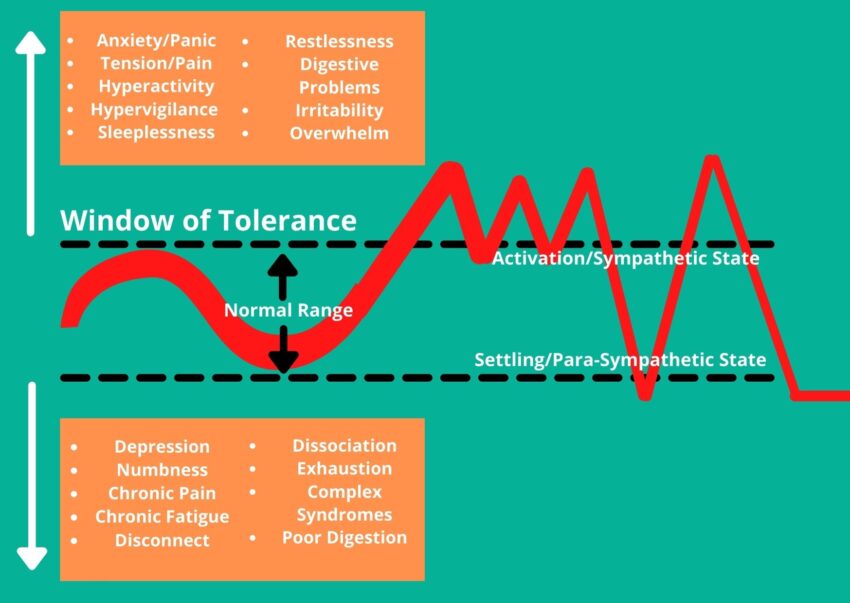Where are we in our window of tolerance?
In this article, Kristin Loeer, a specialist in the physiology of trauma, discusses how our nervous system affects our window of tolerance, the various mental states most of us have cycled through in the past year, and simple steps to help our nervous system self-regulate.

After a year of living with the reality of a global pandemic, it seems to me that most of us have settled into this diminished lockdown life. We are functioning and getting on with things as much as we have to, yet we lack so many of the things that normally enrich our lives and as a result, we feel low and exhausted.
From a nervous system perspective, we collectively may have arrived in what neuroscientist Stephen Porges calls Dorsal Vagal Shutdown.
The picture below shows you a simplification of how our nervous system works.
What happens when we are pushed outside our personal window of tolerance?

We all have what we call a window of tolerance. As we go through life we also go through waves of nervous system activation and settling. Sometimes we are more calm and relaxed and sometimes we get excited or stressed.
While our levels of nervous system activation stay within the range of our normal window we are pretty much okay. However if activation goes on for too long, or if something really big happens, our activation spikes out of our window of tolerance and we experience a variety of debilitating symptoms. When this happens, our nervous system feels under attack. It lets our body know by creating anxiety, irritability and high stress. It mobilises our body into a fight or flight response cycle which may cause increased tension in our muscles, pain, digestive issues and an inability to find rest.
If this state persists for too long there comes a time when the nervous system is running out of resources to maintain this constant high energy state and it begins to push our energy right down to go into a preserving survival state, also called dorsal vagal shutdown.
We experience this as constant low energy, exhaustion, chronic fatigue, and burnout. Chronic pain can also come as a symptom of this state. We find it hard to be hopeful and something inside of us tells us to just not bother and to retreat. We may feel disconnected from others and ourselves and settle into depression.
The Corona Coaster
During most of last year, we all cycled through various complicated nervous system states with many of us trying to figure out how to deal with our fight and flight responses both physically and emotionally, while some of us have frequently dropped into shut down. Some of us, to be fair, were already dealing with being outside of our window of tolerance before we had even heard of the pandemic.
In any case, if you look at the picture above, does it represent what you have been going through on some level? When I look at it I now see what we have come to know as “The Corona Coaster,”- this pandemic’s very own crazy up and down ride of our nervous system.
Where are we now in our window of tolerance?
So where are we in our nervous system a year on from when it all started?
Looking at the picture you can probably point to the exact area where you feel you are at present. If you find yourself outside your window of tolerance, which given the current crisis would really not be surprising, there are some simple things you can do to help your nervous system self-regulate.
Steps to help your nervous system self-regulate
1. Orient
Take a moment to look around you.
Notice what objects or views feel good to look at and linger on them.
Allow your nervous system to take in the simple, yet clear message that things are okay right now in this moment. Sure we are living in a crisis, but right at this minute there is no imminent danger that needs attending to and there are still nice things around.
As you connect to those nice views or objects, notice how your body responds. Can you feel the physical reaction in your body?
Sometimes when we are deep down in dorsal vagal shutdown it can be difficult to connect to anything. Either you just can’t identify it, you keep getting distracted or the pleasant resonance soon flips into sadness. This is very common, so don’t give yourself a hard time. Don’t give up though either.
If you are not sure about what might make you feel good, look at a plant or out the window at the sky, or your cat or dog, so you choose something that is likely to provoke a positive resonance, even if you can’t quite feel it. If you get distracted just notice that and bring yourself back when you can. If looking at it starts making you sad stop and find something else to connect with that has a more simple, positive resonance.
2. Ground
Notice the heaviest point of you. If you are standing, it will be your feet, if you are sitting it may be your feet, your pelvis, or even your back as you lean back into a chair.
Notice that whatever you are making contact with is supporting and containing you and that you can allow yourself to be held and supported by it.
When we live in a fight or flight state our physiology is tense and wound up. It is as though our posture is stuck in the same physical reaction as when we get a fright and we hold our breath, our shoulders go up and our whole body energy drives upwards.
When we acknowledge the ground and take our awareness down there it can help us gradually unwind this upwards tension and bring about the physiological processes that promote a calmer, more relaxed state.
3. Resource
So much of what we love has been taken away from us this past year. All the activities and people we had in our life to give us support, energy, and relaxation we have had to distance ourselves from, yet worries and work increased for many of us. So naturally, we are deprived of the things that help us normally self-regulate.
So be kind to yourself and seek out simple little things that nourish you. You may not be able to go have a massage, but you could get yourself a fancy bubble bath and take some time out. You may not be able to go to the cinema but you can plan an extra special movie night at home.
Be creative in finding simple things that you can put in place to give you some special little experiences throughout the week.
4. Connect
We may call it social distancing but really it should be called physical distancing as we can still connect and be social. We just have to do it a little differently.
Of course, talking to your parents or children on zoom does not replace giving them a hug, but connecting with your family and friends in safe ways is still going to make a big difference to your nervous system, which thrives on social engagement. Arrange socially or physically distanced walks and video calls with family and friends regularly.
If you follow all of the above steps you may feel yourself become more comfortable and at ease in your body and more capable of dealing with the challenges of this current situation.
Feel free to reach out to me to let me know how the above steps are changing your experience of the pandemic.

 Kristin has 10 years experience as a Pilates Teacher, Manual Therapist, NLP, and Movement Coach, while also a Mentor in Pilates Teacher Education.
Kristin has 10 years experience as a Pilates Teacher, Manual Therapist, NLP, and Movement Coach, while also a Mentor in Pilates Teacher Education.
She has dedicated the past 3 years to studying the physiology of trauma as part of her Somatic Experiencing Practitioner training.
Kristin brings together these different approaches of working with the body and mind, in order to help people explore their very own embodied path to the experience of an expanded, authentic and empowered self.
Contact Kristin via her website, or email: info@kristinloeer.com

